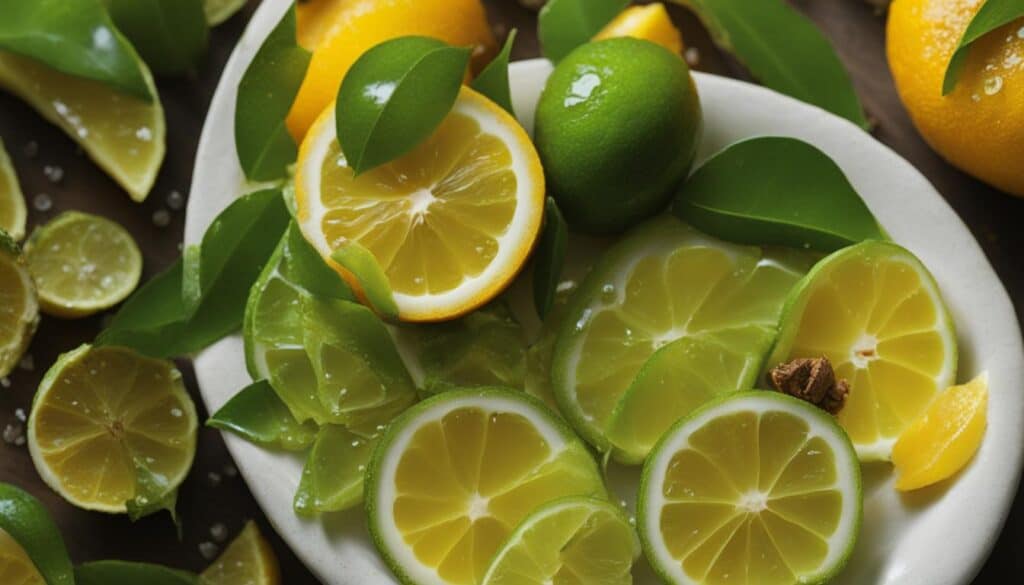Calamansi, also known as Citrofortunella microcarpa, is a citrus fruit native to Southeast Asia. It is easy to cultivate and grows well in cool and elevated areas. Calamansi has a unique citrus flavor and is bursting with health benefits. In this comprehensive guide, we will explore the numerous benefits of calamansi in English, including its uses in recipes and the potential health benefits it provides.
Key Takeaways
- Calamansi, a citrus fruit native to Southeast Asia, has numerous health benefits.
- It is rich in essential nutrients like vitamin C, vitamin A, and potassium.
- Calamansi can be used in various culinary preparations, including juices, sauces, marinades, and desserts.
- Growing your own calamansi tree is a great way to enjoy a steady supply of fresh fruits.
- Choosing calamansi supports sustainable agriculture practices and reduces the environmental impact of citrus farming.
The Rich Nutritional Profile of Calamansi
Calamansi, also known as Citrofortunella microcarpa, is not only a flavorful citrus fruit, but it is also packed with essential nutrients that offer numerous health benefits. This small fruit contains high levels of vitamin C, vitamin A, and potassium, making it a valuable addition to your diet.
Vitamin C is an antioxidant that helps strengthen the immune system, protect against common illnesses, and promote healthy skin. Calamansi provides a significant amount of vitamin C, making it a natural way to boost your immune system and improve overall well-being.
Vitamin A is essential for maintaining healthy vision, promoting cell growth, and supporting immune function. Calamansi is a rich source of vitamin A, which can contribute to the maintenance of good eyesight and a strong immune system.
Potassium is an important mineral that helps regulate blood pressure, balance fluids in the body, and support proper muscle and nerve function. Calamansi contains potassium, making it a nutritious choice to incorporate into your diet to maintain overall health and well-being.
Overall, the rich nutritional profile of calamansi makes it a versatile fruit that can provide various health benefits when consumed regularly.
Comparative Table: Nutritional Content of Calamansi compared to Other Citrus Fruits
| Nutrients | Calamansi (per 100g) | Lemon (per 100g) | Lime (per 100g) | Orange (per 100g) |
|---|---|---|---|---|
| Vitamin C (mg) | 43 | 53 | 29 | 53 |
| Vitamin A (IU) | 42 | 22 | 33 | 225 |
| Potassium (mg) | 103 | 138 | 102 | 181 |
*Values may vary depending on the source and seasonality of the fruits.
As seen in the comparative table above, calamansi stands out with its high vitamin C content, while still offering significant amounts of vitamin A and potassium. This makes calamansi a nutritious choice worth incorporating into your daily diet.
Calamansi in Culinary Delights
Calamansi, with its unique tangy and citrusy flavor, adds a burst of freshness to a wide range of culinary creations. From beverages to sauces, dressings, marinades, and desserts, this versatile fruit is a favorite among chefs and home cooks alike.
One popular use of calamansi is in the form of refreshing calamansi juice. To make this zesty beverage, simply squeeze the juice of calamansi fruits into a glass, add water and sugar to taste, and stir until well combined. For an extra twist, you can also add a few slices of calamansi to your glass for added flavor and visual appeal.
In addition to its juice, calamansi zest is another culinary gem. The zest can be grated or finely chopped and sprinkled over seafood, grilled meats, and salads to infuse them with a tangy and flavorful kick. It can also be used in baking to add a refreshing twist to cakes, cookies, and other sweet treats.
Calamansi Juice Recipe
- Squeeze the juice of calamansi fruits into a glass.
- Add water and sugar to taste.
- Stir until well combined.
- Add a few slices of calamansi for added flavor (optional).

As calamansi is highly acidic, it is important to use it in moderation and balance its flavor with other ingredients. Remember to adjust the amount of calamansi juice or zest according to your personal taste preferences.
“Calamansi adds a tangy and refreshing flavor to both sweet and savory dishes, making it a versatile ingredient in the culinary world.”
So the next time you’re looking to add a unique and vibrant twist to your favorite recipes, reach for calamansi and unleash its delightful flavor in your culinary creations.
Growing your Own Calamansi Tree
If you want to enjoy a steady supply of fresh calamansi, you can consider growing your own calamansi tree. Calamansi trees are easy to cultivate and can be grown in pots or directly in the ground. They require well-drained soil, regular watering, and ample sunlight. With proper care, you can have your own calamansi tree that will provide you with fresh and flavorful fruits.
To start growing your calamansi tree, you can either purchase calamansi seeds or use the seeds from ripe calamansi fruits. Plant the seeds in a pot or directly in the ground, ensuring that they are covered with half an inch of soil. Water the seeds regularly, keeping the soil moist but not waterlogged. Within a few weeks, you will start to see sprouts emerging from the soil.
As the tree grows, make sure to provide it with enough sunlight. Calamansi trees thrive in full sun, so choose a location that receives at least six hours of direct sunlight each day. If you are growing the tree in a pot, you can move it around to ensure it gets enough sunlight throughout the day.
Additionally, make sure to water your calamansi tree regularly, especially during dry periods. The soil should be kept evenly moist, but not waterlogged. You can check the moisture level by sticking your finger about an inch into the soil. If it feels dry, it’s time to water the tree.
Pruning your calamansi tree is also important to promote healthy growth and fruit production. Remove any dead or diseased branches, as well as any crowded or crossing branches. Pruning should be done during the dormant season, which is usually in late winter or early spring.
Table: Calamansi Tree Care Tips
| Care Tips | Details |
|---|---|
| Soil | Well-drained soil |
| Watering | Regular watering, keeping soil moist |
| Sunlight | Full sun, at least six hours of direct sunlight daily |
| Pruning | Remove dead, diseased, crowded, and crossing branches during the dormant season |
With these care tips, you can successfully grow your own calamansi tree and enjoy the abundance of fresh calamansi fruits. Having your own calamansi tree not only provides you with a sustainable source of this citrus fruit but also adds a touch of beauty to your garden. So why not give it a try and start growing your own calamansi tree today?
The Environmental Benefits of Calamansi
Calamansi is not just a delicious and nutritious citrus fruit, it also offers significant environmental benefits. Its cultivation promotes sustainable citrus farming practices and reduces the negative impact on the environment. By choosing calamansi over other citrus fruits, you are actively supporting a healthier planet.
Promoting Biodiversity
Calamansi cultivation encourages biodiversity in agricultural landscapes. Its growth provides habitat and food for various beneficial organisms such as pollinators and predators, contributing to a more balanced ecosystem. This helps maintain the natural balance of pests and diseases, reducing the need for chemical pesticides and promoting a more sustainable farming approach.
Reducing Chemical Usage
Calamansi is known for its resilience to pests and diseases, making it less dependent on chemical interventions. This reduces the need for synthetic pesticides, herbicides, and fertilizers, minimizing the environmental impact of citrus farming. By choosing calamansi, you are supporting a more sustainable and eco-friendly agricultural system.
Preserving Soil and Water Quality
Citrus farming can have detrimental effects on soil and water quality due to excessive use of chemicals and intensive farming practices. However, calamansi cultivation requires fewer inputs and promotes better soil health. Its deep-rooted system helps prevent soil erosion, while its natural resilience reduces the risk of chemical runoff into water sources. This helps preserve soil fertility and maintains the quality of surrounding water bodies.
| Environmental Benefits of Calamansi | |
|---|---|
| Promotes biodiversity in agricultural landscapes | Reduces chemical usage |
| Preserves soil and water quality |
By embracing calamansi as a sustainable choice, you contribute to the well-being of the environment and help protect our natural resources for future generations.
Beauty and Wellness Applications of Calamansi
The versatility of calamansi extends beyond the kitchen. This citrus fruit also offers a wide range of beauty and wellness benefits, making it a popular ingredient in natural remedies. With its high vitamin C content and antioxidant properties, calamansi can work wonders for your skin and hair.
Calamansi is known for its ability to brighten the skin and reduce acne and blemishes. Its natural acids help to exfoliate the skin and promote a more youthful complexion. You can create a simple DIY face mask by mixing calamansi juice with honey or yogurt. Apply the mixture to your face, leave it on for 10-15 minutes, and then rinse off with warm water.
“Calamansi juice is like a refreshing tonic for the skin. It helps to cleanse, rejuvenate, and tighten the pores, leaving your skin looking fresh and radiant.”
In addition to its skin benefits, calamansi can also be used as a natural hair conditioner. The acidic properties of calamansi help to remove build-up and restore shine to dull hair. Simply mix calamansi juice with water and use it as a final rinse after shampooing. Your hair will feel soft, smooth, and revitalized.

The beauty and wellness applications of calamansi are endless. Whether you’re looking to improve your skin, strengthen your hair, or simply pamper yourself with a refreshing citrus-infused treatment, calamansi is a natural and effective choice.
Calamansi in Traditional Medicine
Calamansi, with its rich nutritional profile and numerous health benefits, has been valued in traditional medicine for centuries. This versatile citrus fruit is known for its anti-inflammatory, antimicrobial, and antioxidant properties, making it a popular natural remedy for various ailments.
One of the key benefits of calamansi in traditional medicine is its ability to support the immune system. Due to its high vitamin C content, consuming calamansi regularly can help strengthen your body’s defenses and protect against common illnesses like colds and flu.
In addition to its immune-boosting properties, calamansi is also believed to aid digestion. The fruit contains enzymes that can help improve digestive health and relieve symptoms such as bloating and indigestion.
| Traditional Remedies | Benefits |
|---|---|
| Cold and flu relief | Boosts the immune system |
| Digestive aid | Improves digestion and relieves bloating |
| Anti-inflammatory effects | Reduces inflammation and joint pain |
| Antimicrobial properties | Fights against bacteria and infections |
While calamansi has been used in traditional medicine for centuries, it’s important to note that it should not replace medical advice or treatment for serious conditions. If you are dealing with a health issue, it’s always best to consult a healthcare professional before incorporating calamansi or any natural remedy into your routine. However, adding calamansi to your diet as a preventative measure can be a delicious and beneficial addition to your overall wellness routine.

Exploring Calamansi Recipes
Calamansi, with its tangy and refreshing flavor, is a versatile citrus fruit that adds a delightful twist to various recipes. Whether you’re a fan of savory dishes or have a sweet tooth, there are plenty of ways to incorporate calamansi into your culinary creations. Here are some delicious calamansi recipes to inspire your inner chef:
Savory Delights:
- Calamansi Chicken: Marinate chicken in calamansi juice, soy sauce, garlic, and spices for a few hours before grilling or baking. The result is juicy, flavorful chicken with a citrusy kick.
- Calamansi Vinaigrette: Whisk calamansi juice, olive oil, honey, Dijon mustard, and a pinch of salt and pepper to create a zesty dressing for salads and roasted vegetables.
Sweet Treats:
- Calamansi Bars: Combine calamansi juice, condensed milk, eggs, and flour to make a tangy and creamy filling. Pour it over a crumbly crust, bake until golden brown, and enjoy these irresistible citrus bars.
- Calamansi-Infused Cocktails: Shake up your favorite cocktail by adding a splash of calamansi juice. The bright and citrusy flavors will elevate your drink to new heights.

Whether you’re experimenting with marinades, dressings, desserts, or refreshing beverages, calamansi can take your recipes to the next level. Its unique flavor profile and vibrant acidity make it a delightful ingredient to work with. So go ahead, get creative, and explore the endless possibilities of calamansi in your favorite dishes.
How to Select and Store Calamansi
When it comes to selecting and storing calamansi, there are a few key factors to keep in mind. The quality of the fruit and proper storage techniques can ensure that you have fresh and flavorful calamansi on hand whenever you need it.
Choosing the Best Calamansi
When selecting calamansi, look for fruits that are firm, smooth, and brightly colored. Avoid any fruits that have blemishes, bruises, or soft spots, as these may indicate that the fruit is overripe or damaged. Opt for calamansi with a vibrant yellow or orange hue, as this is a sign of ripeness.
Storing Calamansi
Calamansi can be stored at room temperature for a few days, allowing it to fully ripen and develop its flavors. However, if you want to extend the shelf life of calamansi, it is best to store it in the refrigerator. Place the fruits in a perforated plastic bag or in a container with a lid to prevent them from drying out.
Another way to preserve calamansi is by freezing the juice or zest. Squeeze the juice from the calamansi and pour it into ice cube trays. Once frozen, transfer the calamansi juice cubes to a resealable freezer bag. The frozen juice can be used in various recipes, drinks, or sauces. The zest can also be frozen by grating the peel and storing it in a freezer-safe container.
Table: Tips for Selecting and Storing Calamansi
| Selection Tips | Storage Tips |
|---|---|
| Choose firm, smooth, and brightly colored calamansi | Store at room temperature for a few days or in the refrigerator for up to a week |
| Avoid fruits with blemishes, bruises, or soft spots | Keep in a perforated plastic bag or a container with a lid to prevent drying |
| Look for vibrant yellow or orange hues | Freeze the juice or zest for long-term storage |
By following these tips for selecting and storing calamansi, you can ensure that you always have fresh and flavorful fruits available for your culinary creations. Whether you use calamansi in recipes, beverages, or beauty treatments, the quality and freshness of the fruit can make a significant difference in the final result.
Conclusion
Calamansi, also known as Citrofortunella microcarpa, is a versatile citrus fruit that offers a multitude of benefits. From its rich nutritional profile to its culinary uses, growing your own tree, and its positive environmental impact, calamansi has the potential to enhance your well-being while contributing to a greener world.
By incorporating calamansi into your diet, you can unlock a range of health benefits. Its high vitamin C content boosts your immune system, while its antioxidants protect your body from oxidative stress. Moreover, calamansi’s tangy and citrusy flavor adds a delightful twist to a variety of culinary creations, from refreshing beverages to savory dishes and sweet desserts.
Not only is calamansi a flavorful addition to your kitchen, but it can also be a sustainable choice. Its cultivation promotes biodiversity and reduces the environmental impact of citrus farming. By choosing calamansi, you support sustainable agriculture practices and contribute to a healthier planet.
Whether you use calamansi in beauty remedies, traditional medicine, or explore its endless culinary possibilities, this versatile fruit has the potential to enhance your daily routine. So, unlock the potential of calamansi in English and experience the numerous benefits this citrus fruit has to offer.
FAQ
Where is calamansi native to?
Calamansi is native to Southeast Asia.
What nutrients does calamansi contain?
Calamansi is rich in essential nutrients such as vitamin C, vitamin A, and potassium.
What are the health benefits of calamansi?
Consuming calamansi regularly can boost the immune system, improve digestion, promote healthy skin, and support overall well-being.
How can calamansi be used in cooking?
Calamansi’s tangy and citrusy flavor makes it a perfect addition to beverages, sauces, dressings, marinades, and desserts.
Can I grow my own calamansi tree?
Yes, calamansi trees are easy to cultivate and can be grown in pots or directly in the ground.
Is calamansi a sustainable crop?
Yes, calamansi cultivation promotes biodiversity and reduces the environmental impact of citrus farming.
What are the beauty and wellness benefits of calamansi?
Calamansi can help brighten the skin, reduce acne and blemishes, and act as a natural hair conditioner.
What are the traditional medicinal uses of calamansi?
Calamansi is often used to relieve cold and flu symptoms, aid digestion, and promote overall wellness.
What are some popular calamansi recipes?
Some popular calamansi recipes include calamansi chicken, calamansi vinaigrette, calamansi bars, and calamansi-infused cocktails.
How should I select and store calamansi?
When selecting calamansi, choose fruits that are firm, smooth, and brightly colored. Store at room temperature for a few days or in the refrigerator for up to a week.





Leave a Reply